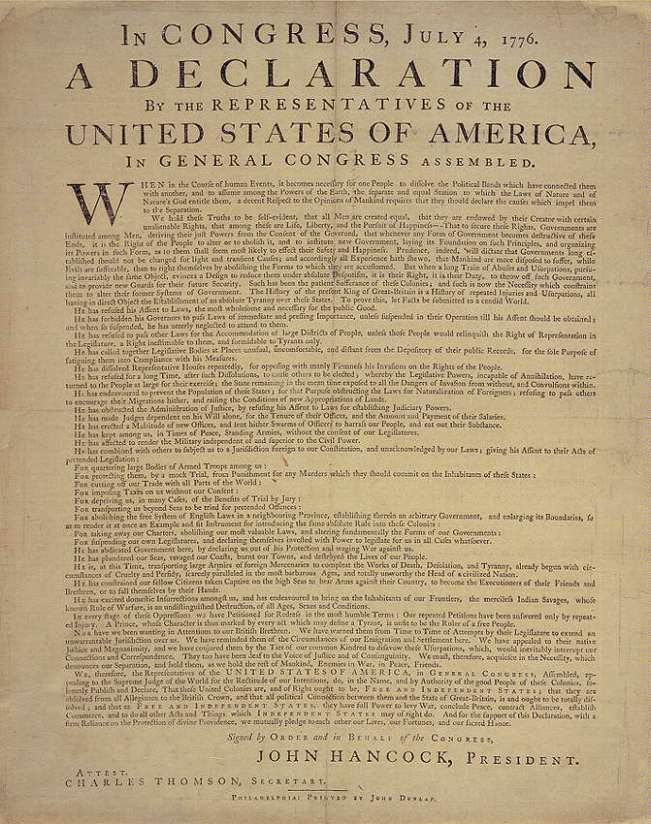

All this is lost in today’s climate." Our ruling The American Revolution made slavery a problem for the world when it had not been a problem before, having existed for thousands of years without substantial criticism.

"The first anti-slave convention in history was held in Philadelphia in 1775. "As the men who drafted and signed the Declaration were mostly gentlemen of standing and property, it's not at all surprising that this would be the case," Wilentz added.īrown University emeritus history professor Gordon Wood said Parsa’s claim reveals how prevalent slavery was.īut, "what's important is that slavery began to be attacked and eliminated from that moment on," Wood said. Princeton University history professor Sean Wilentz noted that at least four men in the painting, including Franklin, were or later became abolitionists.Īlso, in 1776, slavery was legal in all 13 of the new states and was "condoned by the entire West," including Britain and France, he said. John Adams, Samuel Adams, George Clymer, William Ellery, Elbridge Gerry, Samuel Huntington, Thomas McKean, Robert Treat Paine, Roger Sherman, Charles Thomson, George Walton, William Williams and James Willson. Here are the 13 who apparently did not own slaves: The men who did not own slaves also tended to be well-to-do. Livingston, Thomas Lynch, Arthur Middleton, Lewis Morris, Robert Morris, William Paca, George Read, Benjamin Rush, Edward Rutledge, Richard Stockton, William Whipple, Thomas Willing, John Witherspoon, Oliver Wolcott and George Wythe. Josiah Bartlett, Charles Carroll, Samuel Chase, Abraham Clark, George Clinton, John Dickinson, William Floyd, Benjamin Franklin, John Hancock, Benjamin Harrison, Joseph Hewes, Thomas Heyward Jr., William Hooper, Stephen Hopkins, Francis Hopkinson, Thomas Jefferson, Richard Henry Lee.Īnd Francis Lewis, Philip Livingston, Robert R. Here are the 34 men in the painting we found to be slaveholders, in alphabetical order by last name: The slaveholders tended to be men of means, including landowners, doctors, lawyers and local government officials. "The problem is that property records are pretty spotty for the more obscure founders and even some of the bigger names."īut, using books, historical organizations, research articles and other sources, we found there is strong evidence to back Parsa’s claim.

"Most of the quantification is best-guess and based on available records," said historian Terry Bouton at the University of Maryland, Baltimore County. Go here to see a spreadsheet detailing the evidence we examined. Starting with evidence Parsa provided to back up his claim, we did our own research on each of the 47. "I would have assumed that it would be easy to find out how many owned slaves, but it is surprisingly elusive," Baylor University history professor Thomas Kidd told us. None knew of a list that identified how many of the men in the painting were slaveholders. We contacted more than a dozen historians and historical organizations.

With the caveat that there is no one definitive source on this question, we also counted 34. So, Parsa claims that 34 of the 47 founding fathers shown in the painting were slaveholders. Next time someone puts them on a pedestal and says we can't question their judgement on guns or whatever, show them this image." "I decided to put red dots on all the men who held slaves. "This is one of the most famous paintings in American history: Declaration of Independence," Arlen Parsa wrote above an image of the 1818 oil by John Trumbull. The painting depicts a moment in 1776 showing 47 men, including Thomas Jefferson, John Hancock and Ben Franklin, most of whom were signers of the declaration. As the nation observes the 400th anniversary of slavery, a Chicago documentary filmmaker tweeted about the painting Declaration of Independence, which hangs in the rotunda of the U.S.


 0 kommentar(er)
0 kommentar(er)
